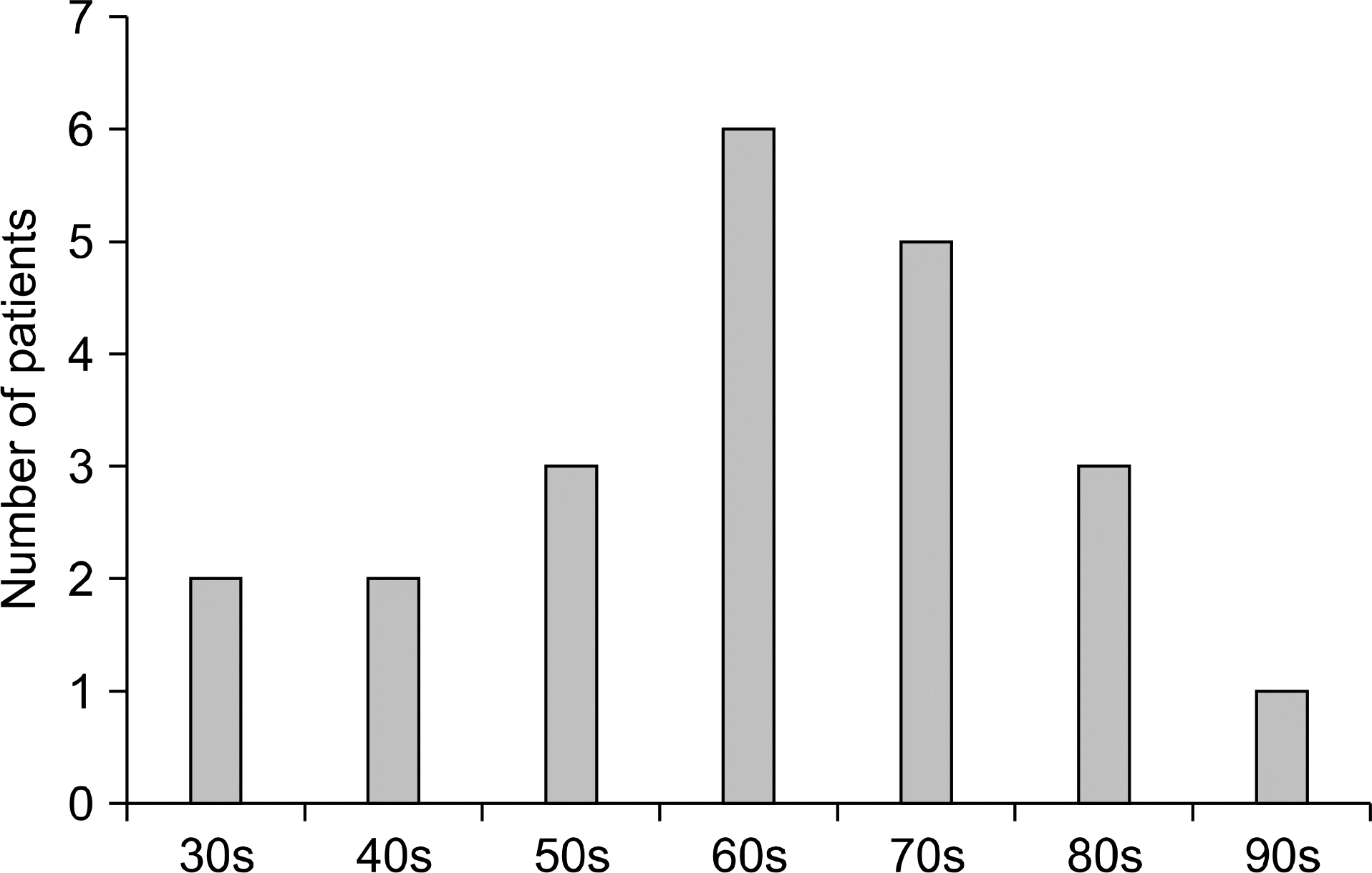초록
Background
Streptococcus agalactiae (Group B streptococcus, GBS) is known to be the leading cause of neonatal sepsis and meningitis in the United States and Europe. In addition, GBS infection has been increasingly noted in adults, particularly in those with underlying diseases, such as diabetes mellitus, malignancy and liver disease. A few studies reported that resistances to antibiotics, such as erythromycin, clindamycin, tetracycline are increasing. We report clinical and microbiological characteristics of GBS bacteremic patients in Jeju Island.
Methods
We retrospectively analyzed medical re-cords, such as age, sex, underlying disease, mortal-ity, skin defects, laboratory results and antibiotic resistances of GBS in hospitalized adult patients who were diagnosed with GBS bacteremia from 2008 to 2013 in Jeju Island.
Results
Twenty two adult patients were diagnosed as GBS bacteremia from 2008 to 2013. The mean age of GBS bacteremic patients was 66.2 years old. Of 22 bacteremic patients, fifteen patients (68%) were older than 60. Twenty patients (91%) of bacteremic patients had underlying diseases such as diabetes mellitus, malignancy and liver disease. Ten (45%) patients had skin defects which were on the lower extremities and buttock, fifteen (68%) patients had fever at the time of admission, twenty one (95%) patients were admitted via the emergency department. Two (9%) patients died. The mean white blood cell (WBC) count, percentile of neutrophil count, and C-reactive protein (CRP) levels were 11,488/μL, 84.3 %, 13.5 mg/dL respectively. All GBS isolates from bacteremia showed sensitivities to penicillin, ampicillin, and vancomycin, and showed resistances to erythromycin (25%), clindamycin (30%), and tetracycline (55%).
Conclusion
Bacteremia caused by GBS was preva-lent in adult patients with underlying diseases. Most of the GBS bacteremic patients were emergency cases, with a high body temperature, WBC, CRP level, and neutrophil count. Half of them had skin defects, which are considered a source of GBS bacteremia.
Go to : 
REFERENCES
1.Kasper DL., Harrison TR. eds. Harrison's Principles of Internal Medicine. 16th ed.New York: McGraw-Hill, Medical Pub. Division;2005. p. 823–31.
2.Uh Y., Jang IH., Yoon KJ., Kim HY. Analysis for Group B streptococci isolated from bacteremic patients. Korean J Clin Microbiol. 2004. 7:43–7.
3.Tazi A., Morand PC., Réglier-Poupet H., Dmytruk N., Billoët A., Antona D, et al. Invasive group B streptococcal infections in adults, France (2007-2010). Clin Microbiol Infect. 2011. 17:1587–9.

4.Takahashi T., Sunaoshi K., Sunakawa K., Fujishima S., Watanabe H., Ubukata K. Invasive Streptococcal Disease Working Group. Clinical aspects of invasive infections with Streptococcus dysgalactiae ssp. equisimilis in Japan: differences with respect to Streptococcus pyogenes and Streptococcus agalactiae infections. Clin Microbiol Infect. 2010. 16:1097–103.
5.Wang TK., Fung AM., Woo PC., Yuen KY., Wong SS. Streptococcus agalactiae (Lancefield group B) bacteraemia in nonpregnant adults. Eur J Clin Microbiol Infect Dis. 2002. 21:140–2.
6.Kamaratos A., Kokkoris S., Tzanakari A., Protopsaltis J., Varytimiadis K., Lentzas J, et al. Group B streptococcus (Streptococcus agalactiae) meningitis in a diabetic adult. Acta Diabetol. 2005. 42:117–8.
7.Schuchat A. Epidemiology of group B streptococcal disease in the United States: shifting paradigms. Clin Microbiol Rev. 1998. 11:497–513.

8.Lee K., Shin JW., Chong Y., Mikamo H. Trends in serotypes and antimicrobial susceptibility of group B streptococci isolated in Korea. J Infect Chemother. 2000. 6:93–7.
9.Jackson LA., Hilsdon R., Farley MM., Harrison LH., Reingold AL., Plikaytis BD, et al. Risk factors for group B streptococcal disease in adults. Ann Intern Med. 1995. 123:415–20.

10.Kim BN., Bae IG., Kim MN., Woo JH., Ryu J., Kim YS. Group B streptococcal bacteremia in nonpregnant adults with hepatic disease in Korea. Eur J Clin Microbiol Infect Dis. 2001. 20:639–42.

11.Uh Y., Choi SJ., Jang IH., Lee KS., Cho HM., Kwon O, et al. Colonization rate, serotypes, and distributions of macrolide-linco-samide-streptogramin B resistant types of group B streptococci in pregnant women. Korean J Clin Microbiol. 2009. 12:174–9.
12.Shin JW., Roh KH., Lee K., Chong Y. Group B streptococcus isolated from bacteremic patients: serotypes and antimicrobial susceptibilities. Korean J Clin Microbiol. 1999. 2:220–4.
13.Uh Y., Kim HY., Jang IH., Hwang GY., Yoon KJ. Correlation of serotypes and genotypes of macrolide-resistant Streptococcus agalactiae. Yonsei Med J. 2005. 46:480–3.
Go to : 
Table 1.
Underlying conditions and clinical features in patients nfected with Streptococcus agalactiae in blood (n=22)
| Characteristic | Number (%) |
|---|---|
| Diabetes mellitus | 6 (27.3) |
| Liver disease | 8 (36.4) |
| Malignancy | 9 (40.9) |
| Skin defect | 10 (45.5) |
| Admitted via ED | 21 (95.5) |
| Fever | 15 (68.2) |
| Death | 2 (9.1) |




 PDF
PDF ePub
ePub Citation
Citation Print
Print



 XML Download
XML Download